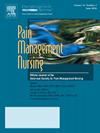Review of Multimodal Therapies for the Treatment of Neuropathic Pain: Clinical Implications
IF 1.6
4区 医学
Q2 NURSING
引用次数: 0
Abstract
Purpose
We summarize the safety and efficacy data from three gabapentinoid (GABA) combinations: GABA + opioid; GABA + antidepressants; and GABA + topical lidocaine and evaluate the benefit risk from each combination.
Methods
Using a recently published systematic review, we identified combination studies of neuropathic pain. In addition, we reviewed publications of GABA + topical lidocaine.
Results
GABA + opioid: We reviewed 6 studies evaluating the combination of an opioid with a GABA (931 total participants). Efficacy results were mixed in this combination. Combination therapy was shown to be superior to monotherapy in some studies, but not in all. Significant AEs were noted with this combination treatment. There were also higher rates of dropouts related to AEs in the combination arm compared to monotherapy. GABA + antidepressant: We reviewed 3 studies evaluating the combination of GABA and antidepressant (472 participants). Efficacy results were mixed in this combination, with combination therapy shown to be superior to monotherapy in some studies. There were no differences in dropouts due to AEs between combination and monotherapy arms. GABA + topical lidocaine: We reviewed 2 studies evaluating the combination of GABA and topical lidocaine (205 participants). Combination therapy was shown to be efficacious in reducing pain from baseline; however, both studies were limited in that both were open-label. The incidence of treatment-related adverse events was low and typically mild to moderate in severity.
Conclusions
Achieving meaningful pain relief in patients suffering from neuropathic pain can be challenging. There are limited effective options available to treat neuropathic pain and the majority are administered systemically resulting in adverse events that primarily affect the CNS, leading to functional limitations and discontinuation of drugs. Combinations of two systemic agents (GABA + opioid, GABA + antidepressants) have resulted in significant AEs and dropouts in clinical studies. On the other hand, combinations of a systemic agent and a topical agent (GABA + topical lidocaine) can confer improved efficacy with minimal additional adverse effects.
Nursing Implications
Topical medications with minimal systemic AEs such as lidocaine patch have shown to be beneficial in many neuropathic pain conditions and may be of benefit to achieve meaningful pain relief in more patients as an adjuvant therapy. Nurses are at the forefront of patie
求助全文
约1分钟内获得全文
求助全文
来源期刊

Pain Management Nursing
医学-护理
CiteScore
3.00
自引率
5.90%
发文量
187
审稿时长
>12 weeks
期刊介绍:
This peer-reviewed journal offers a unique focus on the realm of pain management as it applies to nursing. Original and review articles from experts in the field offer key insights in the areas of clinical practice, advocacy, education, administration, and research. Additional features include practice guidelines and pharmacology updates.
 求助内容:
求助内容: 应助结果提醒方式:
应助结果提醒方式:


